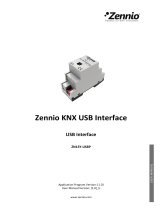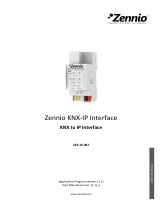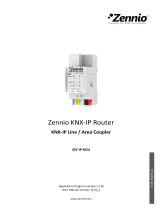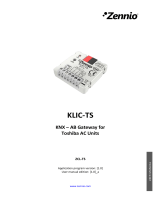Page is loading ...

SKX OPEN
SKX OPEN
ZN1RX-SKXOPEN
Edition 1.1
PRODUCTMANUAL

ZENNiOAVANCEYTECNOLOGÍA www.zennio.com
2
1. Introduction..........................................................................................................................3
1.1. SKX Open....................................................................................................................3
1.2. Application Program: SKX Open..............................................................................3
1.3. SKX Open Overview..................................................................................................4
2. Installation...........................................................................................................................5
2.1. SKX Open installation. KNX Bus..............................................................................5
2.2. SKX Open connection to RS232 port......................................................................5
3. Parameterization................................................................................................................6
3.1. Main Setup...................................................................................................................7
3.2. Parameter Groups....................................................................................................10
3.3. Error Code Communication Object........................................................................12
3.3.1. Possible Errors..................................................................................................12
3.3.2. Example of Errors.............................................................................................
13

ZENNiOAVANCEYTECNOLOGÍA www.zennio.com
3
1.
INTRODUCTION
1.1. SKX OPEN
The SKX Open is the Zennio device that allows connecting the bus KNX with the
RS232 data bus.
Device Features:
Reduced size: 45 x 45 x 14mm.
Designed to be placed either in a wiring box
or inside electrical panels.
Proprietary communication protocol
Several communication speeds and error
correction mechanisms.
Ideal for M2M applications.
Based in an EIB/KNX BIMM112 core.
Total data saving.
Following the CE guidelines
Description of the elements:
Prog: it is the button used to enter the device in Programming Mode. When
pushing it at the beginning, after supplying the bus with power, the device is
forced to enter in Safe Mode.
Led: it is the light signal that indicates that the device is in Programming Mode.
When the device enters in Safe Mode, it blinks with a 0,5 seconds-long cycle
time.
1.2. APPLICATION PROGRAM: SKX OPEN
The goal of this manual is explaining the specific application program developed in
order to connect external devices that can be controlled via a RS232 port to KNX.
The SKX Open is a product for communication between KNX and serial protocol
RS232 in a totally free environment, since it is able to control any device via RS232
independently of the hexadecimal code that the device generates. This is possible by
associating hexadecimal codes with communication objects in the SKX Open
configuration in ETS.

ZENNiOAVANCEYTECNOLOGÍA www.zennio.com
4
Note: Any hexadecimal code can be integrated but some length restrictions for
them must be bear in mind in SKX Open configuration (additional Information in
the section “3.2 Group of parameters”).
Communication between RS232 interface and KNX bus takes place in the SKX
Open device, which allows exchanging information in a bidirectional way. Thus, data
from the KNX bus can be used to control a device linked to the RS232 interface or, the
opposite, it allows controlling KNX devices through 1-bit data typed communication
objects with data from the external device received through the RS232 interface.
Figure 1. SKX Open Bidirectional Communication
1.3. SKX OPEN OVERVIEW
The SKX Open presents a series of features that are configurable in the ETS:
Transmission speed: (1200, 2400, 4800, 9600, 19200)
End of frame recognition with Timeout or End Frame Byte.
44 communication objects
Error detection: 1 byte – error code with bit mask.
Maximum frame length: 10 bytes / 20 HEX characters (without including End
Frame Byte, if exists).
External device SKX Open KNX Installation
RS 232
KNXBus
External
device
KNX

ZENNiOAVANCEYTECNOLOGÍA www.zennio.com
5
2. INSTALLATION
2.1. SKX OPEN INSTALLATION. KNX BUS
The SKX Open installation is performed the same way that any other KNX device.
We just need to connect the device to KNX bus through the specific KNX connector
and it will be ready to be programmed.
Once the device is provided with power supply from the bus, both, the physical
address and the SKX Open application program can be downloaded.
This device does not need external supply, since it just works with the power supply
of KNX bus. Nevertheless, it will be necessary to add an external power supply to the
RS232 bus, independent of the KNX bus power supply, as defined in its standard.
2.2. SKX OPEN CONNECTION TO RS232 PORT
Connection to RS232 port is performed using an unfixed specific wire clamp in SKX
Open, which makes easier its connection and installation.
In the following figure, the SKX Open connection to both protocols (RS232 and
KNX) is shown:
Figure 2. SKX Open Connection
SKX Open wire Clamp BUS RS232
A RSA
B RSB
- GND
+ +12V

ZENNiOAVANCEYTECNOLOGÍA www.zennio.com
6
3. PARAMETERIZATION
Thanks to this application program, any device with a RS232 interface can be
integrated with the KNX system if the hexadecimal codes used for the orders are
known.
The SKX Open provides 48 1bit-typed communication objects, which are used for
interaction between KNX and RS232. Moreover, an additional 1 byte-typed
communication object for Error Control provides information about the problems that
come up when working (non hexadecimal values in parameterization, lower case
letters, odd hexadecimal message length in parameterization, the message received
through the serial port is too long or it contains errors, any error happened in the last
sent message or it happened when comparing the parameterized value with the
received one).
There are four options of controlling each communication object through the
parameters:
KNX => RS232 Communication. Switching:
Sending frame (that is configured as a parameter) to the integrated device
through the serial port when receiving a 1 through the communication object in
KNX bus.
Sending frame (that is configured as a parameter) to the integrated device
through the serial port when receiving a 0 through the communication object in
KNX bus.
SKX OPEN
Interface KNX <=> RS232
Value received
through KNX BUS:
“1” to object 1
Sending to
external device:
Frame CCDD
SKX OPEN
Interface KNX <=> RS232
Sending to
external device:
Frame AABB
Value received
through KNX BUS:
“0” to object 0

ZENNiOAVANCEYTECNOLOGÍA www.zennio.com
7
RS232 => KNX Communication. Switching:
Sending a 0 value to the KNX Bus through the communication object in case
the received frame via the serial port fits the one configured as a parameter.
Sending a 1 value to the KNX Bus through the communication object in case
the received frame via the serial port fits the one configured as a parameter
3.1. MAIN SETUP
Figure 3. SKX Open – Main Setup
SKX OPEN
Interface KNX <=> RS232
Receiving from
external device:
Frame ABCD
Value sent to
KNX BUS:
“0” through object 2
SKX OPEN
Interface KNX <=> RS232
Receiving from
external device:
Frame EEEE
Value sent to
KNX BUS:
“1” through object 3

ZENNiOAVANCEYTECNOLOGÍA www.zennio.com
8
In this tab the parameters regarding the physical communication are configured.
Velocity: 1200-2400-4800-9600-19200
Parity: No parity, even parity, odd parity
Time between frames to be sent: It is the configurable delay time when sending
frames towards the serial port. It allows linking more than one communication
object to the same group address, as the SKX Open will be able to send several
frames coming from different communication objects in an ordered way, which
means a perfect acquiring and interpretation of data in reception. This parameter
will depend on the receptor device.
Reception complete mode: In order to detect the frame ending, there are two
choices:
• Timeout: it is the time while the received frame is being waited since the last
bit was received, so the frame is meant to end after that time.
• End frame byte
: the end of frame can be delimited by a specific byte. Any
time the end frame byte is received by the SKX Open, it recognizes the end of
frame. In this case there is a security timeout in reception that can expire if the
end frame byte is not received. When receiving a frame that is longer than 10
bytes, it will be ignored and a communication object Error Code will be sent to
the KNX bus in order to inform about it.
Example:
An external device takes 80ms to send the complete frame.
First case:
The user configures 200ms for Timeout. Supposing the
external device wants to send a second frame immediately after the first
one, the functioning will be the one represented by the following figure:
Figure 4. Too long Timeout
External device frame
0ms 80ms 100ms 180ms
Time
Frame 1 Frame 2
SKX OPEN
0ms 0ms
Time Out
aborted
Time
30ms20ms
Time Out
finished

ZENNiOAVANCEYTECNOLOGÍA www.zennio.com
9
The SKX Open restarts its Timeout when the frame 1 ends, but before it
expires, the frame 2 is received and thus, the Timeout is restarted again
when frame 2 finishes. This way, the Timeout just expires after frame 2
reception and the SKX Open considers all the information that has been
received until that time (frame 1 and frame 2) as a single frame and
therefore, the SKX Open will not recognize any of them, due to a too long
Timeout value.
Second case:
The user configures 60ms for Timeout. The functioning will
be the one represented by the following figure:
:
Figure 5. Too short Timeout
In this case, the external device has not enough time to send the frame
before the Timeout ends. The SKX Open does not receive the complete
frame and thus, it does not recognize it. This is due to the too short
Timeout.
The Timeout must be defined according to the time between frames in the
external device transmission. If it is not taken into account and the Timeout is too
long or too short, frames reception could have errors.
Example: This is a real case where the Timeout value must be correctly
configured for a right reception of the frames. When the SKX Open (at right)
receives an order from SKX Open (at left) through RS232 port, it sends an
acknowledge frame (ACK) and a Status frame, separated by 60ms time. If the
Timeout value in SKX Open is longer than 60ms, the SKX Open will not detect
any of the frames, and thus, will not update the status in SKX Open.
External device frame
0ms 80ms 100ms 170ms
Frame
1 Frame 2
SKX OPEN
0ms 10ms
Time
Time
Time
Out
10ms
Time
Out
0ms

ZENNi
O
3.2.
I
n
The
r
O
AVANCEYTEC
N
PARA
M
n
this tab,
r
e are 4 gro
N
OLOGÍA
Figure 6
.
M
ETER
G
the group
ups with 1
2
Figu
.
Example
w
G
ROUP
S
of commu
n
2
1 bit-type
d
r
e 7. SKX
O
w
ith SKX
O
S
n
ication ob
j
d
communi
c
O
pen – Pa
r
O
pen and
S
j
ects that
w
c
ation obje
c
r
ameter G
r
S
KX Open
w
e need
m
c
ts each.
r
oups
www.zen
m
ust be en
a
nio.com
a
bled.
1
0

ZENNiOAVANCEYTECNOLOGÍA www.zennio.com
1
1
Figure 8. SKX Open – Group X
In Group X tab (there is one tab for each enabled group), the control mode and
frames to be sent/received are selected for each communication object:
Obj X. Control mode: This parameter allows defining if the communication
object is used for a KNX to RS232 or RS232 to KNX communication, as well
as the effects of the control:
For KNX => RS232 Communication
• Send frame if object is 0: Send the frame (configured in the
parameter “Obj X. Frame to send”) to the external device through
the serial port when the value of the communication object is 0.
• Send frame if object is 1: Send the frame (configured in the
parameter “Obj X. Frame to send”) to the external device through
the serial port when the value of the communication object is 1.
For RS232 => KNX Communication
• Object is 0 if frame fits: Send a 0 value of the communication
object to the KNX bus when receiving a frame that fits the one that
is set as a parameter “Obj X. Received frame” through the serial
port.
• Object is 1 if frame fits: Send a 1 value of the communication
object to the KNX bus when receiving a frame that fits the one that
is set as a parameter “Obj X. Received frame” through the serial
port.
According to the chosen control mode (KNX => RS232 or RS232 => KNX) we need
to configurate the corresponding parameter in each case:

ZENNiOAVANCEYTECNOLOGÍA www.zennio.com
1
2
Obj X. Frame to send or Obj X. Received frame: In this field we set the
frames that must be taking into account by SKX Open for communication
KNX => RS232 or RS232 => KNX respectively. The strings that we input in
these fields must fulfill the following requirements:
• The characters must correspond to hexadecimal values (0-9, A-F).
• The characters A-F must be input in upper case letters.
• The frame length must be an even, as two characters correspond to
1byte hexadecimal value.
Note I:
There is a communication object Error Code for controlling the string that
the user configures in this tab. This error control takes place during set-up.
Note II:
If we want to use a 2 bytes-length hexadecimal frame, such as “0x2B
0x7F”, it must be input in the ETS parameters with the format “2B7F”.
3.3. ERROR CODE COMMUNICATION OBJECT
Figure 9. Communication object – Error code
The 1byte-typed communication object indicates the current problems in the
communication using an accumulative code or bit mask. Each bit of the communication
object value has a special meaning:
• Bit 0.
No hexadecimal character in any configured frame
• Bit 1.
Upper case character in any configured frame
• Bit 2.
Odd length in any configured frame
• Bit 3.
The error, which is defined with the rest of the bits, is in the
current frame.
• Bit 4.
There is an error in the RS232 port communication, such as
velocity, parity, frame length…
• Bit 5. The received frame is longer than 10bytes.
3.3.1. POSSIBLE ERRORS
The communication object Error Code is updated and sent to the KNX bus in the
following cases:

ZENNiOAVANCEYTECNOLOGÍA www.zennio.com
1
3
Error Definition
N° of error
(in setup and when it
does not happen in the
current frame)
N° of error when it
happens in the
current frame
Error: Empty string in frame parameter
NO 09h (bit0 and bit3)
Error: End Frame Byte is not received
NO 28h (bit5 and bit3)
Error: Communication parameters
18h (bit4 and bit3) 18h (bit4 and bit3)
Error: No hexadecimal value
01h (bit0) 09h (Bit0 and bit3)
Error: Odd length value
04h (bit2) 0Ch (bit2 and bit3)
Error: Lower case character in frame
02h (bit1) 0Ah (bit1 and bit3)
Error: Frame length
NO 28h (Bit5 and Bit3)
3.3.2. EXAMPLE OF ERRORS
Empty string in frame parameter: In case an object is enabled and the frame
field in parameterization is empty an error with code 09 will take place.
Example
: In this case, when the object value is 0, this error will take place.
Figure 10. Empty string in frame parameter
Figure 11. Error code when there is an empty string in frame parameter
End Frame Byte is not received: If the detection of the frame end is an End-
Frame Byte and it is not received when the timeout expires or there is an error in
the received value, and thus it is not detected, an error with code 28 will take
place.

ZENNiOAVANCEYTECNOLOGÍA www.zennio.com
1
4
Example: If the user defines an End Frame Byte FF, the frame reception will be
successful if the byte FF is received. If the external device sends 02ADFA
(because of a transmission error) or it sends 02ADFF but it takes more than 60ms
(in our example), the SKX Open will send the error code 28 to the bus.
Figure 12. End Frame Byte FFh
Figure 13. Error code when End Frame Byte is not received
Error in Communication Parameters: If the configured parameters (velocity,
parity, etc) in Main Setup tab do not match the ones of the external device an error
with code 18 will be sent to the bus.
Example:
The external device has a velocity of 9600Bauds and the SKX Open is
expected to receive data at 1200 Bauds speed. The error code would be 18 in this
case.
No hexadecimal value: If a no hexadecimal value is input in a parameter field in
SKX Open configuration, this error is sent to the bus with code 01.
Example
: The value in the frame parameter field in ETS is 4D5G. In this case, the
error code 01 will be sent to the bus during set-up.
Figure 14. No hexadecimal value
Odd length value: If a value with odd length is input in a parameter field in SKX
Open configuration, this error is sent to the bus with code 04.
Example
: The value in the frame parameter field in ETS is 4D5. In this case, the
error code 04 will be sent to the bus during set-up.

ZENNiOAVANCEYTECNOLOGÍA www.zennio.com
1
5
Figure 15. Odd length value
Lower case character: If a value with a lower case character is input in a
parameter field in SKX Open configuration, this error is sent to the bus with code
02.
Example:
The value in the frame parameter field in ETS is ABcD. In this case, the
error code 02 will be sent to the bus during set-up
Figure 16. Lower case character
Frame length: If configured frame length is longer than 10 bytes, the error code
28 will be sent to the bus.
Example:
The value in the frame parameter field in ETS is
0123456789ABCDEF012345, which is 12bytes long. In this case, the error code 28
will be sent to the bus.
The error happens in the current frame: if when sending a configured frame it
contains any of the previous errors, the error code object is sent to the bus, but not
the frame.

ZENNiOAVANCEYTECNOLOGÍA www.zennio.com
1
6
ZENNIOTECHNICALDOCUMENTATION
¡BECOMEAUSER!
http://zennioenglish.zendesk.com/portal
TECHNICALSUPPORT
/









